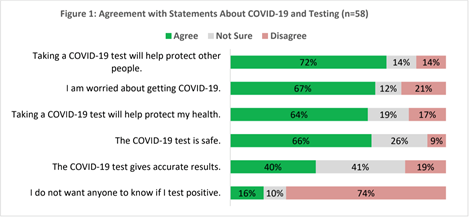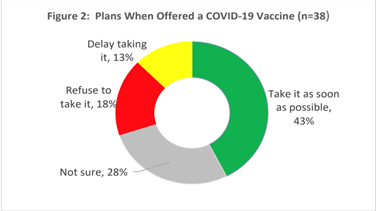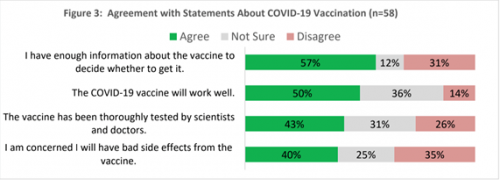
By Tiffany Devlin & Aparna Komarla
The Covid In-Custody Project partners with the Davis Vanguard to bring quantitative and qualitative reporting on the pandemic’s impact on county jails and CDCR to the public eye. This story is authored by the Covid In-Custody team.
While the United States’ COVID-19 vaccination rate of 59.6% has been of much concern to health administrators, several carceral institutions across the country have even lower rates leaving those in congregated settings vulnerable to contracting the virus. In Alameda County’s Santa Rita Jail only 25% of those currently in custody are vaccinated.
These statistics are more concerning in light of the Delta variant, which is known to be highly virulent, contagious and deadly.
There is a widespread availability of vaccines at Santa Rita Jail, however, a distrust in the medical field appears to be holding the incarcerated population back from achieving herd immunity. According to a survey conducted by the Public Health Dept. during March and April — the beginning of the vaccine rollout — roughly 50% of respondents felt that the vaccines had not been thoroughly tested by doctors or scientists. One even wrote, “It kills people.”
To ensure that anyone in custody who wants to be vaccinated is able to do so, Wellpath, the jail’s medical provider, offers vaccines to newly booked individuals on day 12, 13, and 14 of the mandatory intake quarantine period. Incarcerated people can also submit a medical request form or make a sick call if they wish to be vaccinated.
With a vaccination rate of 25% for the population and 10%* for jail staff, recent data on COVID-19 cases and housing unit quarantines suggest that the jail is far from being out of the woods with the pandemic.
Active COVID-19 cases among jail staff and contractors surged to 16 on Aug. 4 — a 90% increase in 24-hours. After months of declining numbers, another surge of 110% occurred on Aug. 15 for the incarcerated population, leaving 21 active cases in custody.
Several studies have shown that infections among staff are a primary vector for outbreaks in incarcerated populations. In fact, an independent consultant who monitors Santa Rita Jail’s COVID-19 response, identified that cases among staff triggering the jail’s largest outbreak to date — over 100 active cases were reported on a single day during December. A Wellpath representative also admitted, “contact tracing revealed that the outbreak could have been linked to staff positives.”
Health administrators have attempted to curb this transmission by mandating testing for jail staff, but a vaccine mandate is not in sight. In March, Dr. Nicholas Moss, the Alameda County health officer, ordered all Santa Rita Jail staff to get tested once every two weeks. On July 26, the health officer for California ordered all county jails t0 ascertain the vaccination status of their staff, and ensure that unvaccinated staff are being tested weekly.
While these are steps in the right direction to curtail the transmission of COVID-19, medical evidence unequivocally shows that testing cannot substitute vaccinations.
Additionally, the implementation of protocol is often far from the official narrative. The Sheriff’s Office failed to meet the requirements of the March mandatory testing order for jail staff since the compliance rate never reached 100%, and staff members were not being tested in exactly 14-day intervals. The statewide-mandate for weekly testing of unvaccinated jail staff is yet to be implemented — jails have until August 23 to put a plan in place.
For the incarcerated population, the test acceptance rate is all the more concerning. The acceptance rate in housing units quarantined due to exposure to a positive case averages to 74%. Roughly 42% of new books consent to a test during the intake process.
The refusal rate for testing offered to individuals medical vulnerabilities, pod workers, and those housed in open-air dorms, averages to roughly 62%. Individuals awaiting release or transfers have an average refusal rate of 10%.
Insufficient testing, combined with low vaccination rates, could be a recipe for more outbreaks in the upcoming months.
The beginning of vaccine rollout for jail staff
In December 2020, a vaccine distribution plan for Alameda County outlining eligibility criteria was adopted by the public health department. The county was expecting their first shipment of the Pfizer vaccine by Dec. 18.
When the distribution plan was developed, specifically as of Dec. 10, 2020, there were 33,736 total cases of COVID-19 and 525 deaths in Alameda County. The jail had 277 total cases and no deaths during that time.
According to the plan, “… people in prisons, jails, detention centers, and similar facilities, and staff who work in such settings,” were included in Phase 2. Phase 1A, however, included high-risk health workers, first responders and those in long-term care facilities. This meant that medical staff who worked at Santa Rita Jail were eligible.
Mike Durbin, Health Services Administrator for Wellpath, stated that they received 120 doses from the county for eligible medical staff in February. At the time, only 62% of clinical staff had consented.
As of July 20, data from Wellpath shows that the vaccination rate has improved by 15% in 5 months. Out of 216 staff members — 134 full-time and 82 part-time — roughly 77% are fully vaccinated. 35 reported that they have chosen not to get vaccinated, and 14 refused to disclose any information on their status.
Currently, there is no prioritization framework in place — anyone who wants to get vaccinated is able to do so.
Lack of data on vaccine acceptance among jail staff
In Santa Clara County, only 50% of deputies accepted the vaccine according to a Public Safety and Justice Committee report in early February, a “shocking and disappointing statistic” according to Supervisor Wilma Chen. Unlike Santa Clara, counties like San Francisco and Sacramento did not make any data on vaccine acceptance among staff publicly available until months after the rollout.
Until May, Alameda County also did not provide any statistics on staff vaccinations despite multiple requests by the Covid In-Custody Project. Under Phase 2 of the vaccine distribution plan, law enforcement officers in city police departments, Sheriff’s Office, Probation Department, etc. were eligible to get vaccinated through clinics organized by the Office of Emergency Services. Their data tracking system, however, failed to record the law enforcement body and division a recipient belonged to. Consequently, no data could be compiled on Sheriff’s Office staff or Santa Rita Jail staff who got vaccinated through these clinics.
Herd immunity among jail staff is far-fetched
The lack of clean data did not stop jail representatives from making unfounded claims about the vaccine acceptance rate.
In March, speaking for the Alameda County Sheriff’s Office, Undersheriff Richard Lucia told the Board of Supervisors that roughly 75% of staff were willing to be vaccinated and 25% were not sure and/or would want to wait for the second vaccination period. “We’re pretty confident that a very large number of deputies will get vaccinated,” he assured them. Lucia also promised that the official numbers would be provided soon.
Captain Dan Brodie similarly indicated that jail staff had taken advantage of the vaccine availability, leading to low case numbers among staff and contractors.
These empty statements had no basis in fact or knowledge. As of May 30, 39% of Sheriff’s Office staff are fully vaccinated and 56% have received at least one dose according to the public health department. Since data from the Office of Emergency Services’ vaccine clinics was not available, the public health department matched records of vaccinated individuals in California’s Immunization Registry with the Sheriff’s Office roster.
While the state’s immunization registry has limitations like missing data and improper identification, the biggest limitation with the data obtained is the lack of disaggregation among Sheriff’s Office divisions. It does not specify how many staff under the Sheriff’s Office custody division are vaccinated, and instead pools all divisions together, masking the degree of immunity among jail staff who interact directly with the incarcerated population on a daily basis.
To combat this issue, the Covid In-Custody Project (a). requested the Sheriff’s Office to conduct a survey to ascertain the vaccination status of staff and record the division they belong to, and (b). requested Commander Sanchez and Captain Luckett-Fahimi to tally the number of vaccination cards submitted by Sheriff’s Office staff to Human Resources. While an update on the survey has been pending for several months, the latter request was fulfilled.
Using the Human Resources data as of August 2, among 1722 total Sheriff’s Office staff, only 456 or 26% are fully vaccinated. Even more concerning is the custody division’s vaccination rate. Of the 746 staff permanently assigned to SRJ — 466 sworn and the remaining civilian — only 77 or 10% are fully vaccinated. There are 448 sworn staff from other duty stations that work at the jail on mandatory over-time, however they are not included in the custody division vaccination rate.
It is possible that several staff members who are fully vaccinated may not have reported their status to Human Resources, evidenced by the higher vaccination rate from the immunization registry data. However, all staff have been urged to submit their vaccination cards and are given consistent reminders, according to Captain Luckett-Fahimi.
Despite the claims from Undersheriff Lucia and Captain Brodie that their staff have taken full advantage of vaccination opportunities, the official data tells a different story.
Jail staff vaccinations across Bay Area
The Santa Clara County Sheriff’s Office has reported that as of May 7, 58% of custody sworn staff and 73% of custody civilian staff are vaccinated.
In response to a Public Records Act request on jail staff vaccinations for the San Francisco County Sheriff’s Office, out of the 455 sworn staff assigned to custody, 269 or 45% have self-reported as fully vaccinated to Human Resources.
New health order for jail staff could be a game changer for data transparency
A Public Health Officer Order issued on July 26 by the California Department of Public Health states that current mitigation strategies such as universal masking for staff in healthcare or high-risk congregate settings, are not proving to be sufficient in preventing transmission of the Delta variant, which is much more contagious and may cause more severe illness.
The order requires that high-risk congregate settings, including state and local correctional facilities and detention centers, must verify and track the vaccine status of all workers. Additionally, the records of vaccination verification must be made available, upon request, to the local health jurisdiction for purposes of case investigation.
Unvaccinated or incompletely vaccinated workers are also required to undergo screening testing, where they must be tested at least once weekly.
Kimi Watkins-Tartt, director of Alameda County’s public health department, and Captain Luckett-Fahimi stated that since the July 26 order has been issued by the state, the local county public health body cannot enforce or monitor the implementation. The Sheriff’s Office Human Resources will be responsible for tracking the vaccination status of all staff members and providing a list of those who must get tested weekly. “It is our expectation that the Sheriff’s Office will comply as this isn’t guidance, it’s a Health Order,” Watkins-Tartt emphasized. She also stated that her office will be requesting monthly reports in order to track the Sheriff’s compliance.
While testing will reduce the occurrences of transmission between staff and population, studies have shown that it is not as effective in doing so as vaccines.
Mandatory testing not only provides insufficient protection, but also introduces heavy financial costs. According to the Sheriff’s Office, the first bi-weekly testing requirement issued by the county’s health officer cost approximately $36,000 per month. The Sheriff is attempting to utilize the Coronavirus Emergency Supplemental Funding (CESF) grant of $1 million to cover the expenditure.
If the vaccination rate does not improve, the cost of implementing the new weekly testing requirement may be double that of the first testing mandate. The expenditure could come up to anywhere from $60,000 to $70,000 per month — a cost that can easily be avoided if the majority of staff were vaccinated.
Captain Luckett-Fahimi was unaware of how the weekly testing requirement would be funded.
The beginning of vaccine rollout for incarcerated people
On March 1, Wellpath, the jail’s medical provider, began administering vaccinations to medically vulnerable patients. They initially offered 101 first-doses, which 79 people or 78% accepted.
However, the vaccine acceptance rate dropped significantly over the next 5 weeks. By April 5, around 1201 vaccines (first-dose Moderna and Johnson & Johnson) were offered within a population of nearly 2200 people, of which only 412 individuals or less than 34% accepted.
In the month of May, Wellpath discontinued reporting the number of individuals who have been offered vaccines due to potential duplicates. According to Mike Durbin, duplicates arise when individuals who previously declined a vaccine request one at a later point. In response, the Covid In-Custody Project argued that this data point is crucial to quantify vaccine hesitancy and devise solutions to improve uptake.
For new books, vaccines are offered on days 12, 13, and 14 of their mandatory intake quarantine period. Meaning, anyone entering Santa Rita Jail custody is given an opportunity to get vaccinated at the beginning of their incarceration. Further, the general population can request to get vaccinated through a sick call or medical request form.
Vaccine hesitancy and medical distrust
A survey developed by Alameda County’s public health department to track incarcerated people’s views on COVID-19 vaccinations and testing was offered on tablets and on paper between March 23 through April 16. A bilingual phone line was also available for translation. The survey and various flyers were also translated into all threshold languages.
The survey was recently featured in a report that was prepared by the Community Assessment, Planning and Evaluation (CAPE) Unit of the Alameda County Health Care Services Agency and Public Health Department.
Out of over 2000 people in custody who had the opportunity to participate in the survey, only 60 submitted viable responses.
30% of respondents reported that they currently have, or have had, COVID-19. Around 35% of respondents reported that they received at least one dose of a COVID-19 vaccine.
The top reasons for respondents choosing to get tested for COVID-19 were for protecting their health, or other people.

The most common answer for not having had a COVID-19 test was that it had not been offered to them.
Similarly in regards to vaccine distribution, four people said that they had not been offered a vaccine, or that they had asked and are still waiting.
One individual noted quarantine issues, stating that, “I took the test, and it didn’t matter people around me were still contracting the virus. We were not really quarantined as we were supposed to be.”
The second most common answer for not having had a COVID-19 test was due to lack of trust. One individual responded, “I don’t trust it,” when asked.
Among the 40 unvaccinated respondents, 43% said they would take it as soon as possible and 18% said that they would refuse.

When respondents were asked if they believed there was enough information available on the vaccine to decide on taking it, 43% said that they disagreed or were not sure.

“I got the vaccine because I didn’t wanna risk coming home with covid and passing it to family, friends, and those that I come in contact with,” one respondent said after being asked why they would take the vaccine.
After being asked why they would not take the vaccine, one respondent said that, “they ask us if we want the shot, they don’t tell us which manufacturer they have, until we agree to get it.”
Improving vaccine acceptance rates
Currently, there have been no shortages of vaccines identified since the early stages of vaccine rollouts. Vaccines are offered to the population on Tuesdays, Wednesdays, and Thursdays of each week.
In the past, in order to encourage individuals to take the vaccine, educational flyers were posted around the jail. Currently, the Sheriff’s Office is developing a new educational flyer based on the Delta Variant, as well as vaccination data. A small commissary item and a telephone gift card are being provided as incentives to those who accept either two doses of Moderna, or one dose of Johnson & Johnson in order to increase vaccine acceptance.
Looking forward
Since the surge of the Delta Variant, businesses have been increasingly making vaccines mandatory for employees with limited exceptions.
Under a recent mandate in San Francisco, city employees who work in the jails or other high risk congregate settings are required to be vaccinated by Sept. 15. The union that represents San Francisco Sheriff’s deputies, however, stated that a number of their employees will either quit or retire early if they are forced to get vaccinated.
When Kimi Watkins-Tartt was asked whether a mandatory vaccine order could be issued for Santa Rita Jail staff, she stated that neither public health nor the county have determined that they will mandate vaccinations. However, as more institutions and workplaces start to implement their own mandates, she would not be opposed to the idea.
Recently, the Covid In Custody Project reported that federal receiver J. Clark Kelso, who oversees medical care inside California’s prisons, asked a federal judge for a mandatory COVID-19 vaccination order for guards and staff at the prisons given the Delta variant risk.
“We cannot afford to be lulled by the decline in infections in CDCR, which mirrored the fall in rates in the larger community.” Kelso wrote to the court regarding the conditions within CDCR facilities.
Kelso stated that only 42% of custody staffers in state prisons have received at least one dose of the vaccine, and that overall only 53% of all staff have had one shot. Further, the report states that half of all outbreaks between May and July were traced back to employees, claiming that testing as a substitute for vaccination is not sufficient.
Likewise, the risk is just as great within California jails, especially since it has already been reported within Santa Rita Jail. Echoing the words of federal receiver Kelso, testing cannot be used as a substitute for vaccines.
* The 10% fully vaccinated rate for jail staff is likely an undercount since it deviates significantly from the 39% fully vaccinated rate reported through the CAIR data for the entire Alameda County Sheriff’s Office staff. Unlike the CAIR data, the data used to calculate the 10% vaccination rate is self-reported vaccination cards submitted to HR.
Access the Covid In-Custody Project’s data here: www.covidincustody.org/data -> Access Raw Data -> Alameda County